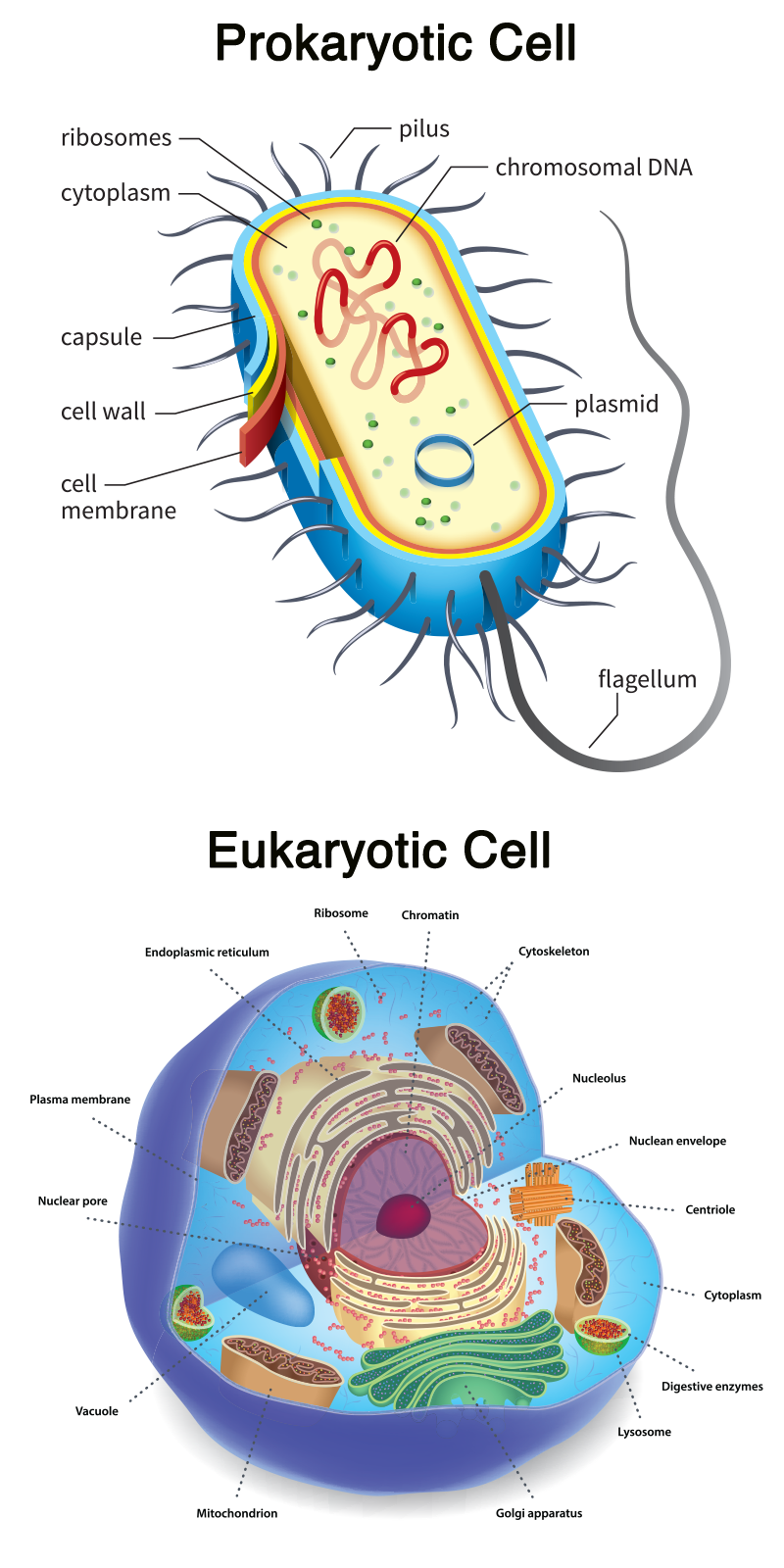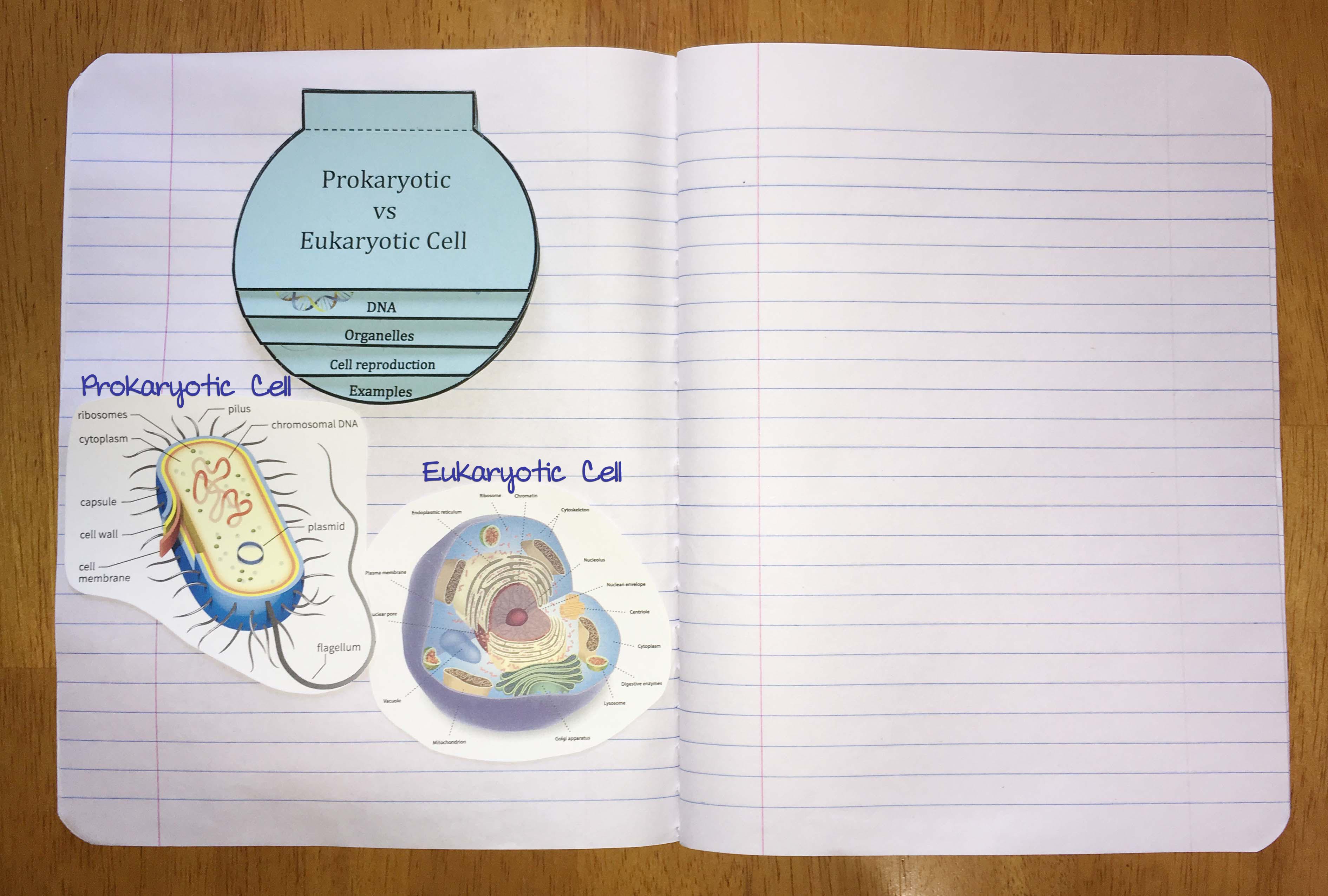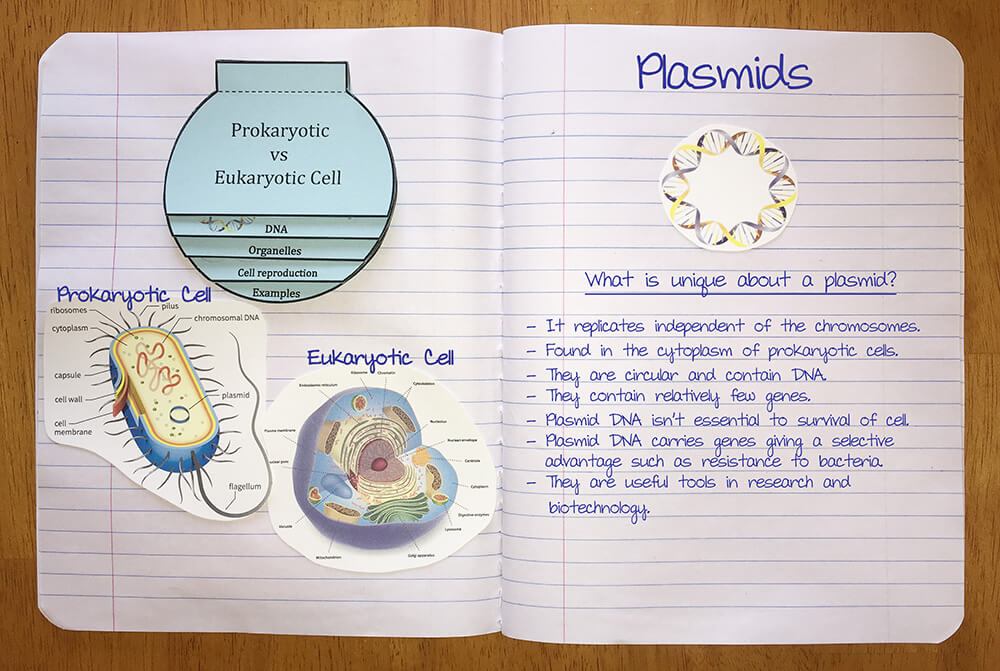Plasmid Problem Solving
This lesson compares and contrasts prokaryotic and eukaryotic cells and examines the form and function of the plasmid found in prokaryotic cells. Students will then use these principles to simulate how a desirable gene can be isolated and inserted into a plasmid as one step in the process of creating a bioengineered (GMO) plant variety.
Background
Lesson Activities
Recommended Companion Resources
Credits
Author
Andrea Gardner, Heather McPherson, and Mariel Sellers | National Center for Agricultural Literacy (NCAL) and Syngenta
Acknowledgements
Activity 3 was written by Heather McPherson and Mariel Sellers as part of the Syngenta Summer Fellowship Educator's Guide. The remaining activities were developed and added with permission by the National Center for Agricultural Literacy.
Sources
- https://bitesizebio.com/13522/who-found-the-first-plasmid/
- http://www.encyclopedia.com/science-and-technology/biology-and-genetics/genetics-and-genetic-engineering/plasmid
- https://gmoanswers.com/current-gmo-crops
- Pharmacogenomics. (n.d.). Retrieved October 11, 2016, from https://www.boundless.com/biology/definition/pharmacogenomics/.
- Biotechnology in Medicine - Boundless Open Textbook. (n.d.). Retrieved October 11, 2016, from https://www.boundless.com/biology/textbooks/boundless-biology-textbook/biotechnology-andgenomics-17/biotechnology-119/biotechnology-inmedicine-480-11702/.
- https://www.ncbi.nlm.nih.gov/pmc/articles/PMC5250645/
- “By Planting Insect resistant Cotton, Researchers Hope.” (n.d.). Insect-resistant Crops Through Genetic Engineering. Retrieved October 11, 2016, from http://www.aces.uiuc.edu/vista/html_pubs/biotech/insect.htm.
- Green, J. M., & Owen, M. D. K. (2011). “Herbicide-Resistant Crops: Utilities and Limitations for Herbicide-Resistant Weed Management.” Journal of Agricultural and Food Chemistry, 59 (11), 5819–5829. http://doi.org/10.1021/jf101286h.
- “What Is Bioremediation?” (n.d.). Retrieved October 11, 2016, from http://www.hawaii.edu/abrp/biordef.html.
Standards
Texas Content Area Standards
-
World Geography Studies: 113.43.d.21
Social studies skills. The student applies critical-thinking skills to organize and use information acquired through established research methodologies from a variety of valid sources, including technology. The student is expected to:
- World Geography Studies: 113.43.d.21.D: analyze information by sequencing, categorizing, identifying cause-and-effect relationships, comparing, contrasting, finding the main idea, summarizing, making generalizations and predictions, drawing inferences and conclusions, and developing connections over time
- World Geography Studies: 113.43.d.21.F: formulate and communicate visually, orally, or in writing a claim supported by evidence and reasoning for an intended audience and purpose
-
Economics with Emphasis on the Free Enterprise System and Its Benefits: 113.31.d.21
Social studies skills. The student applies critical-thinking skills to organize and use information acquired through established research methodologies from a variety of valid sources, including technology. The student is expected to:
- Economics with Emphasis on the Free Enterprise System and Its Benefits: 113.31.d.21.A: analyze economic information by sequencing, categorizing, identifying cause-and-effect relationships, comparing, contrasting, finding the main idea, summarizing, making generalizations and predictions, and drawing inferences and conclusions
- Economics with Emphasis on the Free Enterprise System and Its Benefits: 113.31.d.21.F: formulate and communicate visually, orally, or in writing a claim supported by evidence and reasoning for an intended audience and purpose
-
English I: 110.36.c.1
Developing and sustaining foundational language skills: listening, speaking, discussion, and thinking--oral language. The student develops oral language through listening, speaking, and discussion.
- English I: 110.36.c.1.A: engage in meaningful and respectful discourse by listening actively, responding appropriately, and adjusting communication to audiences and purposes;
- English I: 110.36.c.1.B: follow and give complex oral instructions to perform specific tasks, answer questions, or solve problems and complex processes;
- English I: 110.36.c.1.D: participate collaboratively, building on the ideas of others, contributing relevant information, developing a plan for consensus building, and setting ground rules for decision making
-
English I: 110.36.c.11
Inquiry and research: listening, speaking, reading, writing, and thinking using multiple texts. The student engages in both short-term and sustained recursive inquiry processes for a variety of purposes.
- English I: 110.36.c.11.F: synthesize information from a variety of sources
-
English I: 110.36.c.4
Comprehension skills: listening, speaking, reading, writing, and thinking using multiple texts. The student uses metacognitive skills to both develop and deepen comprehension of increasingly complex texts.
- English I: 110.36.c.4.A: establish purpose for reading assigned and self-selected texts
- English I: 110.36.c.4.G: evaluate details read to determine key ideas
- English I: 110.36.c.4.I: monitor comprehension and make adjustments such as re-reading, using background knowledge, asking questions, and annotating when understanding breaks down
-
English I: 110.36.c.5
Response skills: listening, speaking, reading, writing, and thinking using multiple texts. The student responds to an increasingly challenging variety of sources that are read, heard, or viewed.
- English I: 110.36.c.5.B: write responses that demonstrate understanding of texts, including comparing texts within and across genres
- English I: 110.36.c.5.E: interact with sources in meaningful ways such as notetaking, annotating, freewriting, or illustrating
- English I: 110.36.c.5.F: respond using acquired content and academic vocabulary as appropriate
-
English II: 110.37.c.4
Comprehension skills: listening, speaking, reading, writing, and thinking using multiple texts. The student uses metacognitive skills to both develop and deepen comprehension of increasingly complex texts.
- English II: 110.37.c.4.A: establish purpose for reading assigned and self-selected texts
- English II: 110.37.c.4.F: make inferences and use evidence to support understanding
- English II: 110.37.c.4.G: evaluate details read to determine key ideas
- English II: 110.37.c.4.I: monitor comprehension and make adjustments such as re-reading, using background knowledge, asking questions, and annotating when understanding breaks down
-
English II: 110.37.c.1
Developing and sustaining foundation language skills: listening, speaking, discussion, and thinking--oral language. The student develops oral language through listening, speaking, and discussion.
- English II: 110.37.c.1.A: engage in meaningful and respectful discourse when evaluating the clarity and coherence of a speaker's message and critiquing the impact of a speaker's use of diction and syntax
- English II: 110.37.c.1.B: follow and give complex oral instructions to perform specific tasks, answer questions, or solve problems and complex processes
- English II: 110.37.c.1.D: participate collaboratively, building on the ideas of others, contributing relevant information, developing a plan for consensus building, and setting ground rules for decision making
-
English III: 110.38.c.1
Developing and sustaining foundational language skills: listening, speaking, discussion, and thinking--oral language. The student develops oral language through listening, speaking, and discussion.
- English III: 110.38.c.1.A: engage in meaningful and respectful discourse when evaluating the clarity and coherence of a speaker's message and critiquing the impact of a speaker's use of diction and syntax
- English III: 110.38.c.1.B: follow and give complex instructions, clarify meaning by asking pertinent questions, and respond appropriately
- English III: 110.38.c.1.D: participate collaboratively, offering ideas or judgments that are purposeful in moving the team toward goals, asking relevant and insightful questions, tolerating a range of positions and ambiguity in decision making, and evaluating the work of the group based on agreed-upon criteria
-
English III: 110.38.c.4
Comprehension skills: listening, speaking, reading, writing, and thinking using multiple texts. The student uses metacognitive skills to both develop and deepen comprehension of increasingly complex texts.
- English III: 110.38.c.4.A: establish purpose for reading assigned and self-selected texts
- English III: 110.38.c.4.F: make inferences and use evidence to support understanding
- English III: 110.38.c.4.G: evaluate details read to understand key ideas
- English III: 110.38.c.4.I: monitor comprehension and make adjustments such as re-reading, using background knowledge, asking questions, annotating, and using outside sources when understanding breaks down
-
English III: 110.38.c.5
Response skills: listening, speaking, reading, writing, and thinking using multiple texts. The student responds to an increasingly challenging variety of sources that are read, heard, or viewed.
- English III: 110.38.c.5.B: write responses that demonstrate analysis of texts, including comparing texts within and across genres
- English III: 110.38.c.5.E: interact with sources in meaningful ways such as notetaking, annotating, freewriting, or illustrating
- English III: 110.38.c.5.F: respond using acquired content and academic vocabulary as appropriate
-
English II: 110.37.c.5
Response skills: listening, speaking, reading, writing, and thinking using multiple texts. The student responds to an increasingly challenging variety of sources that are read, heard, or viewed.
- English II: 110.37.c.5.B: write responses that demonstrate understanding of texts, including comparing texts within and across genres
- English II: 110.37.c.5.E: interact with sources in meaningful ways such as notetaking, annotating, freewriting, or illustrating
- English II: 110.37.c.5.F: respond using acquired content and academic vocabulary as appropriate
-
English IV: 110.39.c.1
Developing and sustaining foundational language skills: listening, speaking, discussion, and thinking--oral language. The student develops oral language through listening, speaking, and discussion.
- English IV: 110.39.c.1.A: engage in meaningful and respectful discourse when evaluating the clarity and coherence of a speaker's message and critiquing the impact of a speaker's use of diction, syntax, and rhetorical strategies
- English IV: 110.39.c.1.B: follow and give complex instructions, clarify meaning by asking pertinent questions, and respond appropriately
- English IV: 110.39.c.1.D: participate collaboratively, offering ideas or judgments that are purposeful in moving the team toward goals, asking relevant and insightful questions, tolerating a range of positions and ambiguity in decision making, and evaluating the work of the group based on agreed-upon criteria
-
English IV: 110.39.c.4
Comprehension skills: listening, speaking, reading, writing, and thinking using multiple texts. The student uses metacognitive skills to both develop and deepen comprehension of increasingly complex texts.
- English IV: 110.39.c.4.A: establish purpose for reading assigned and self-selected texts
- English IV: 110.39.c.4.F: make inferences and use evidence to support understanding
- English IV: 110.39.c.4.G: evaluate details read to analyze key ideas
- English IV: 110.39.c.4.I: monitor comprehension and make adjustments such as re-reading, using background knowledge, asking questions, annotating, and using outside sources when understanding breaks down
-
English IV: 110.39.c.5
Response skills: listening, speaking, reading, writing, and thinking using multiple texts. The student responds to an increasingly challenging variety of sources that are read, heard, or viewed.
- English IV: 110.39.c.5.B: write responses that demonstrate analysis of texts, including comparing texts within and across genres
- English IV: 110.39.c.5.E: interact with sources in meaningful ways such as notetaking, annotating, freewriting, or illustrating
- English IV: 110.39.c.5.F: respond using acquired content and academic vocabulary as appropriate
-
Advanced Plant and Soil Science: 130.25.c.1
The student demonstrates professional standards/employability skills as required by business and industry. The student is expected to:
- Advanced Plant and Soil Science: 130.25.c.1.B: apply competencies related to resources, information, interpersonal skills, and systems of operation in plant systems.
-
World History Studies: 113.42.d.28
Social studies skills. The student understands how historians use historiography to interpret the past and applies critical-thinking skills to organize and use information acquired from a variety of valid sources, including technology. The student is expected to:
- World History Studies: 113.42.d.28.E: analyze information by sequencing, categorizing, identifying cause-and-effect relationships, comparing, contrasting, finding the main idea, summarizing, making generalizations and predictions, drawing inferences and conclusions, and developing connections between historical events over time
- World History Studies: 113.42.d.28.F: formulate and communicate visually, orally, or in writing a claim supported by evidence and reasoning for an intended audience and purpose
-
Advanced Plant and Soil Science: 130.25.c.16
The student identifies how plants grow and how specialized cells, tissues, and organs develop. The student is expected to:
- Advanced Plant and Soil Science: 130.25.c.16.A: compare cells from different parts of the plant, including roots, stems, and leaves, to show specialization of structures and functions.
- Advanced Plant and Soil Science: 130.25.c.16.B: sequence the levels of organization in multicellular organisms that relate the parts to each other and the whole.
-
Advanced Plant and Soil Science: 130.25.c.17
The student diagrams the structure and function of nucleic acids in the mechanism of genetics. The student is expected to:
- Advanced Plant and Soil Science: 130.25.c.17.A: describe components of deoxyribonucleic acid (DNA) and illustrate how information for specifying the traits of an organism is carried in DNA.
- Advanced Plant and Soil Science: 130.25.c.17.B: identify and illustrate how changes in DNA cause phenotypic or genotypic changes.
- Advanced Plant and Soil Science: 130.25.c.17.C: compare and contrast genetic variations observed in plants and animals.
-
Biology: 112.42.c.1
Scientific and engineering practices. The student, for at least 40% of instructional time, asks questions, identifies problems, and plans and safely conducts classroom, laboratory, and field investigations to answer questions, explain phenomena, or design solutions using appropriate tools and models. The student is expected to:
- Biology: 112.42.c.1.A: ask questions and define problems based on observations or information from text, phenomena, models, or investigations
- Biology: 112.42.c.1.E: collect quantitative data using the International System of Units (SI) and qualitative data as evidence
- Biology: 112.42.c.1.F: organize quantitative and qualitative data using scatter plots, line graphs, bar graphs, charts, data tables, digital tools, diagrams, scientific drawings, and student-prepared models
-
Biology: 112.42.c.2
Scientific and engineering practices. The student analyzes and interprets data to derive meaning, identify features and patterns, and discover relationships or correlations to develop evidence-based arguments or evaluate designs. The student is expected to:
- Biology: 112.42.c.2.A: identify advantages and limitations of models such as their size, properties, and materials
- Biology: 112.42.c.2.B: analyze data by identifying significant statistical features, patterns, sources of error, and limitations
-
Biology: 112.42.c.3
Scientific and engineering practices. The student develops evidence-based explanations and communicates findings, conclusions, and proposed solutions. The student is expected to:
- Biology: 112.42.c.3.A: develop explanations and propose solutions supported by data and models and consistent with scientific ideas, principles, and theories
- Biology: 112.42.c.3.B: communicate explanations and solutions individually and collaboratively in a variety of settings and formats
- Biology: 112.42.c.3.C: engage respectfully in scientific argumentation using applied scientific explanations and empirical evidence
-
Biology: 112.42.c.5
Science concepts--biological structures, functions, and processes. The student knows that biological structures at multiple levels of organization perform specific functions and processes that affect life. The student is expected to:
- Biology: 112.42.c.5.A: relate the functions of different types of biomolecules, including carbohydrates, lipids, proteins, and nucleic acids, to the structure and function of a cell
- Biology: 112.42.c.5.B: compare and contrast prokaryotic and eukaryotic cells, including their complexity, and compare and contrast scientific explanations for cellular complexity
-
Biology: 112.42.c.11
Science concepts--biological structures, functions, and processes. The student knows the significance of matter cycling, energy flow, and enzymes in living organisms. The student is expected to:
- Biology: 112.42.c.11.B: investigate and explain the role of enzymes in facilitating cellular processes
 Most eukaryotic cells contain one or more chromosomes found in the nucleus of animal and plant cells. Chromosomes are made of strands of DNA, which contains the genetic code of an organism. A plasmid is a genetic structure in a cell that can replicate independently of the chromosomes. Plasmids are a small circular strand of DNA found in the cytoplasm of prokaryotic cells such as bacterium or protozoan. While both structures contain DNA, plasmid and chromosomal DNA differ. First, plasmids have relatively few genes (less than 30) compared to chromosomal DNA. Second, plasmid DNA is not usually essential to the survival of the cell (bacteria), but instead carries genes that confer a selective advantage on their host such as a resistance to bacteria, fungi, or antibiotics. In contrast, chromosomal DNA carries essential information for the life of the cell. Third, while chromosomal DNA replicates as part of mitosis or meiosis, plasmids complete their own replication process completely separate from the chromosomes. In nature, plasmids can be passed between two bacterial strains by a set of transfer genes located on the plasmid. The proteins produced by the transfer genes bind to the DNA within the plasmid. When a break or “nick” occurs in the plasmid, the DNA unwinds and the new DNA can enter the strand bridging the gap in the plasmid DNA and potentially allowing the plasmid to inherit the new trait.2
Most eukaryotic cells contain one or more chromosomes found in the nucleus of animal and plant cells. Chromosomes are made of strands of DNA, which contains the genetic code of an organism. A plasmid is a genetic structure in a cell that can replicate independently of the chromosomes. Plasmids are a small circular strand of DNA found in the cytoplasm of prokaryotic cells such as bacterium or protozoan. While both structures contain DNA, plasmid and chromosomal DNA differ. First, plasmids have relatively few genes (less than 30) compared to chromosomal DNA. Second, plasmid DNA is not usually essential to the survival of the cell (bacteria), but instead carries genes that confer a selective advantage on their host such as a resistance to bacteria, fungi, or antibiotics. In contrast, chromosomal DNA carries essential information for the life of the cell. Third, while chromosomal DNA replicates as part of mitosis or meiosis, plasmids complete their own replication process completely separate from the chromosomes. In nature, plasmids can be passed between two bacterial strains by a set of transfer genes located on the plasmid. The proteins produced by the transfer genes bind to the DNA within the plasmid. When a break or “nick” occurs in the plasmid, the DNA unwinds and the new DNA can enter the strand bridging the gap in the plasmid DNA and potentially allowing the plasmid to inherit the new trait.2 Image source
Image source 

